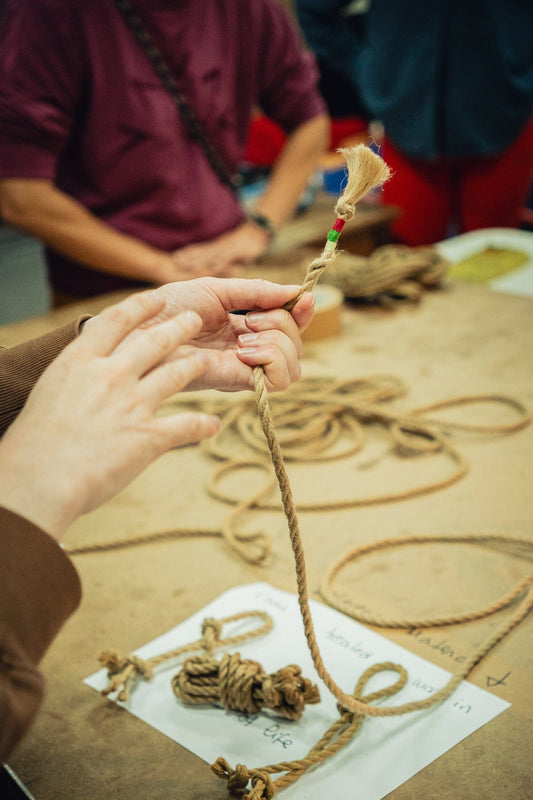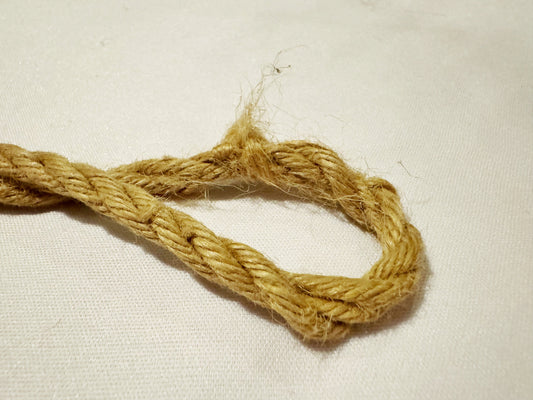Some of the best ropes we have seen and tied with were treated simply by use, in fact many Japanese riggers explain that their rope treatment simply involves tying a lot (and we mean a lot) with the ropes until they become beautiful and easy to use.
So why spend so much time and effort on the treatment process? There are some real pros, and even a few cons to treating your ropes. In this article we'll explain these so you can make an informed decision.
Raw rope is painful to use. Probably the main reason to treat ropes is that untreated ropes don’t feel very nice on the body for the person being tied or on the fingers of the person tying. The raw ropes feel rough due to the coarseness of jute fibres and the fact they're usually rather dry. With enough use the friction of rope against rope slowly softens the rope, and the natural oils from your skin penetrate the ropes.
The treatments we apply to the ropes simply serve to mimic this process, softening and conditioning your ropes in a consistent way. Consistency is key here. Importantly the choice and mix of wax and oils are there to mimic our own natural sebum, which is what makes those untreated ropes feel so beautiful over time.
The two most commonly used oils used for treating shibari ropes are Camellia oil and Jojoba oil. These are what we use to condition all the treated ropes we sell. If you want to treat your own ropes you can buy these oils from us.
Both of these oils are what are called ‘carrier oils’ or ‘base oils’ - these are generally oils made from vegetables, fruits, nuts, and seeds. These base oils are filled with essential fatty acids which is why they are so beneficial and the uses are endless. Some of these oils can be used in cooking, cleaning, skincare, hair care, massage, aromatherapy, cosmetics, homemade beauty and cleaning products, healing and medicinal purposes and practically anything else you can think of.
Both Camellia and Jojoba oils are a great choice for treating jute ropes: they are light(ish) oils, odourless and fantastic for the skin. They also have decent shelf lives (up to 2 years) and penetrate easily into the fibres of the ropes.
The ‘Camellia sinensis' and ‘Camellia oleifera oil’ are the ones referred to as Camellia oil in general and may be used interchangeably. The Camellia japonica oil is better known as ‘Tsubaki oil’ and it is also very slightly different in terms of its chemical composition. The oil is extracted using solvent extraction or cold processing. At Anatomie Studio we source pure cold pressed Camellia oleifera oil. Tsubaki oil is much harder and a lot more expensive to get in Europe, so it is likely that when people refer to Tsubaki oil in Europe, it is in fact Camellia oleifera that is being used.
- Camellia sinensis oil – This is the tea seed oil.
- Camellia japonica oil – Also known as Japanese tea oil. However, this plant does not produce tea leaves. It is a flowering plant with red blooms. Its oil is known as tsubaki oil and it is used heavily in cosmetic applications.
- Camellia oleifera oil – This is known as tea oil or Camellia oil.
Properties:
Camellia Seed Oil-(Tea Oil, Tea Seed Oil)
Botanical Name: Camellia Sinesis, Camellia Oleifera Camellia Oil (Oleifera)
Source: Camellia Flower Seed (Asia)
Shelf Life of 2 years
Botanical Name: Camellia oleifera
Origin: Asia /Japan
Extraction Method: Cold pressed
Colour: Clear Yellow
Scent/Aroma: Light, Herbal
Viscosity: Medium
Obtained From: The seed
Contains: Vitamin E, Polyphenols, Squalene, Omega3, Omega 6, Omega 9
Fatty Acids: High Oleic (80%)
Uses: Food, Skincare, Hair care, Cosmetics
Benefits/Properties: Moisturising, Penetrating, Emollient, Conditioning, Cooling, Improves, Complexion, Promotes Hair Growth, Antioxidant Properties, Known as “Geisha’s beauty secret”
Because Camellia oil is more ‘watery’, we often combine it with organic beeswax which we melt together to form our treatment paste. Natural fibre jute ropes need both the waxiness and the oiliness in order for the ropes to become beautiful, smooth and have the right ‘flow’.
Jojoba oil on the other hand is not really an oil but a liquid wax so we do not combine it with beeswax but rather use it on its own. This is great for vegan rope-lovers. Some people swear by this oil and will treat their ropes by exclusively applying layers of the oil until the ropes feel right. Other people will apply the Jojoba oil as a final layer after the treatment process is done to give it that nice golden shine and silkiness we all love. Because Jojoba is composed of wax esters, it is an extremely stable, long lasting substance, and does not easily deteriorate or turn rancid. Jojoba is considered ‘the’ premium carrier for essential oils and is a luxurious emollient treat for the skin.
Furthermore, the structure of Jojoba oil closely resembles own skin sebum – our skin’s lubricating medium - which is exactly what makes ropes feel and look amazing. It has a natural affinity to our skin is readily absorbed without making the skin greasy or tacky.
Properties:
Jojoba Oil Gold CP (Organic)
Botanical Name: Simmondsia chinensi
Source: Jojoba Beans “goat nut”
5 years Shelf Life
Origin: USA
Extraction Method: Cold pressed
Colour: Golden
Scent/Aroma: Slightly Nutty-Odorless
Viscosity: Thick (Liquid Wax) (Can become Cloudy or Separate which is normal)
Obtained From: The jojoba bean
Contains: Protein, minerals, a waxy substance that mimics collagen. Vitamin B, E, Copper, Chromium, Silicon, Zinc
Fatty Acids: Eruic, Gadoleic, Oleic
Uses: Skincare, Hair care, Cosmetics
Benefits/Properties: Quickly Absorbs, Nourishing, Protective Properties, Similar to Collagen, Can Clog Pores, yet allows skin to breath, Dissolves excess sebum, Can extend shelf life of other oils, antioxidant Properties.
Aside from these oils, we have also heard of people using Olive oil and Coconut oil on ropes. Olive oil has similar properties to Camellia oil, except that it is more viscous which means it is more likely to stay on the surface of ropes (and skin) rather than easily penetrating inside them. It also has a distinct odour which many people find unpleasant in shibari ropes. Coconut oil on other hand is a warm and dry oil - with hight melting point (25 degrees C), it’s basically a solid -, more importantly it is highly "comedogenic" meaning that the molecular structure of coconut oil is simply too large for the rope fibres and skin to absorb, so instead of benefiting the material it will sit on top of it.
There are many (many) other fantastic carrier oils out there, and the information is readily available online, so before experimenting make sure you do your research. Ideally you will want an oil that has a decent shelf life (that will essentially not rot your ropes), odourless (because many people can be sensitive to odours and perfumes), and which has a light or medium viscosity so that it penetrates easily inside the ropes rather than siting on the surface. It’s worth checking price tags too, some oils are harder to find in different parts of the world, for example, Jojoba oil can cost 3 to 5 times as much as Camellia in Europe.
We hope you enjoyed reading this - if you can any questions leave us a message in the comments section below.






3 comments
What is the difference between hemp and jute as far as rope goes? Also, can hemp seed oil be used for treating rope and, if so, how does it compare to camellia and jojoba oils?
Hi Alice, while I don’t know much about hardwood floors, if you’re mixing wax with an oil as part of the defuzzing process for rope then I’d suggest camellia oil. You could also use jojoba – technically that’s a “liquid wax”, so you’d use less beeswax in that case.
Hello,
I am learning how to prepare hemp rope for use in repairing heartpine hardwood floors. Hemp is recommended after it is prepared by removing rope ‘hairs’ and then treated with beeswax and an oil. What oil do you recommend to mix with the beeswax? I will appreciate your input! Many thanks, Alice